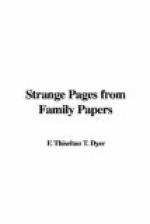hath burst its cold tabernacle, and risen from the
dust.” No human power could drive it away.
It hath “been torn in pieces, burnt, and otherwise
destroyed, but even on the subsequent day it is seen
filling its wonted place. Yet it was always observed
that sore vengeance lighted on its persecutors.
One who hacked it in pieces was seized with such horrible
torments in his limbs that it seemed as though he
might be undergoing the same process. Sometimes,
if only displaced, a fearful storm would arise, so
loud and terrible that the very elements themselves
seemed to become the ministers of its wrath.”
Nor will this eccentric piece of mortality allow the
little aperture in which it rests to be walled up,
for it remains there still, whitened and bleached
by the weather, “looking forth from those rayless
sockets upon the scenes which, when living, they had
once beheld.” Towards the close of the
last century, Thomas Barritt, the Manchester antiquary,
visited this skull—“this surprising
piece of household furniture,” as he calls it,
and adds that “one of us who was last in company
with it, removed it from its place into a dark part
of the room, and there left it, and returned home.”
But on the following night a violent storm arose in
the neighbourhood, causing an immense deal of damage—trees
being blown down and roofs unthatched—and
the cause, as it was supposed, being ascertained,
the skull was replaced, when these terrific disturbances
ceased. And yet, as Thomas Barritt sensibly remarks,
“All this might have happened had the skull never
been removed; but withal it keeps alive the credibility
of the tradition.” Formerly two keys were
provided for this “place of a skull,” one
being kept by the tenant of the Hall, and the other
by the Countess of Ellesmere, the owner of the property.
The Countess occasionally accompanied visitors from
the neighbouring Worsley Hall, and herself unlocked
the door, and revealed to her friends the grinning
skull of Wardley Hall.[10]
[Illustration: She opened it in
secret.]
Another romantic story is associated with Burton Agnes
Hall, between Bridlington and Driffield, Yorkshire,
which is haunted by the spirit of a lady a former
co-heiress of the estate—who is popularly
known as “Awd Nance.” The skull of
this lady is carefully preserved in the Hall, and
so long as it is left undisturbed all goes well, but
whenever any attempt is made to remove it, the most
unearthly noises are heard in the house, and last
until it is restored. According to a local tradition,
many years ago the three co-heiresses of the estate
of Burton Agnes were possessed of considerable wealth,
and finding the ancient mansion, in which they resided,
not in harmony with their ideas of what a home should
be suited to their position, determined to erect a
house in such a style as should eclipse all others
in the neighbourhood. The most prominent organiser
of the scheme was the younger sister, Anne, who could




